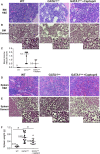Captopril mitigates splenomegaly and myelofibrosis in the Gata1low murine model of myelofibrosis
- PMID: 29971909
- PMCID: PMC6111823
- DOI: 10.1111/jcmm.13710
Captopril mitigates splenomegaly and myelofibrosis in the Gata1low murine model of myelofibrosis
Abstract
Allogeneic stem cell transplantation is currently the only curative therapy for primary myelofibrosis (MF), while the JAK2 inhibitor, ruxolitinib. Has been approved only for palliation. Other therapies are desperately needed to reverse life-threatening MF. However, the cell(s) and cytokine(s) that promote MF remain unclear. Several reports have demonstrated that captopril, an inhibitor of angiotensin-converting enzyme that blocks the production of angiotensin II (Ang II), mitigates fibrosis in heart, lung, skin and kidney. Here, we show that captopril can mitigate the development of MF in the Gata1low mouse model of primary MF. Gata1low mice were treated with 79 mg/kg/d captopril in the drinking water from 10 to 12 months of age. At 13 months of age, bone marrows were examined for fibrosis, megakaryocytosis and collagen expression; spleens were examined for megakaryocytosis, splenomegaly and collagen expression. Treatment of Gata1low mice with captopril in the drinking water was associated with normalization of the bone marrow cellularity; reduced reticulin fibres, splenomegaly and megakaryocytosis; and decreased collagen expression. Our findings suggest that treating with the ACE inhibitors captopril has a significant benefit in overcoming pathological changes associated with MF.
Keywords: drug repurposing; myelofibrosis; myeloproliferative neoplasms.
© 2018 Virginia Commonwealth University. Journal of Cellular and Molecular Medicine published by John Wiley & Sons Ltd and Foundation for Cellular and Molecular Medicine.
Figures



References
-
- Passamonti F, Maffioli M, Cervantes F, et al. Impact of ruxolitinib on the natural history of primary myelofibrosis: a comparison of the DIPSS and the COMFORT‐2 cohorts. Blood. 2014;123:1833‐1835. - PubMed
-
- Kroger NM, Deeg JH, Olavarria E, et al. Indication and management of allogeneic stem cell transplantation in primary myelofibrosis: a consensus process by an EBMT/ELN international working group. Leukemia. 2015;29:2126‐2133. - PubMed
-
- Tefferi A, Vainchenker W. Myeloproliferative neoplasms: molecular pathophysiology, essential clinical understanding, and treatment strategies. J Clin Oncol. 2011;29:573‐582. - PubMed
Publication types
MeSH terms
Substances
Grants and funding
LinkOut - more resources
Full Text Sources
Other Literature Sources
Molecular Biology Databases
Miscellaneous

